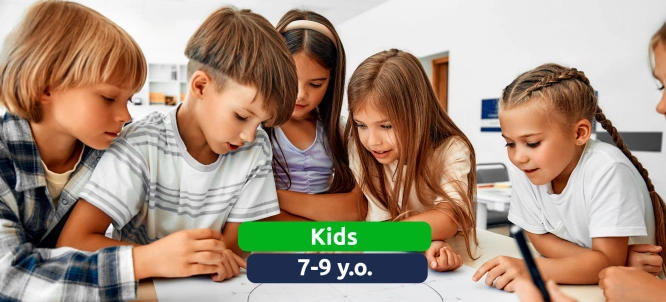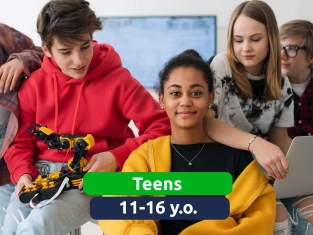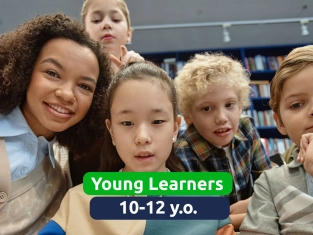by PushtoLearn
Placement Test for Kids
Table of Contents
Placement Test for Kids - Two Parts
This placement test consists of two parts and 50 questions.
|
Points (out of 50) |
Percentage |
Level |
CEFR band |
|
0 – 20 |
0 – 40 % |
Beginner |
A1 |
|
21 – 31 |
41 – 62 % |
Elementary |
A2 |
|
32 – 40 |
63 – 79 % |
Pre‑Intermediate |
B1 |
|
41 – 46 |
80 – 92 % |
Intermediate |
B2 |
|
47 – 50 |
93 – 100 % |
Upper‑Intermediate |
C1 |
Placement Test for Kids: Guide and Tips
A placement test for kids is a great way to determine a child’s English level, so teachers can design classes that best match their needs and skills. These tests are usually designed to be simple, friendly, and enjoyable to keep young learners engaged. The questions will cover areas such as vocabulary, grammar, reading comprehension, and sometimes speaking and listening.

What is a Placement Test?
A placement test helps teachers find out what a child already knows and what they need to learn. This means kids are placed in a class level where they can learn new things at the right pace. Placement tests for kids are usually shorter and simpler than those for adults, focusing on core areas like:
-
Vocabulary: Recognizing and understanding words and their meanings
-
Grammar: Basic sentence structure and common tenses
-
Reading Comprehension: Understanding simple sentences or paragraphs
-
Listening and Speaking: Following instructions, basic pronunciation, and responding to questions
Structure of a Placement Test for Kids
Each section in a placement test has different types of questions, including multiple choice, fill-in-the-blank, picture matching, or short-answer questions. Here’s a breakdown of the common sections:
|
Section |
Skills Assessed |
Example Question Type |
|
Vocabulary |
Recognizing basic words and objects |
Match words with pictures, fill-in-the-blank |
|
Grammar |
Understanding sentence structure |
Choose the correct word to complete a sentence |
|
Reading Comprehension |
Reading and understanding short passages |
Answering questions about a story |
|
Listening/Speaking |
Listening to instructions, basic speaking |
Answering simple questions, repeating words |
Common Errors and How to Avoid Them
Kids often make simple mistakes because they’re still learning, and placement tests are designed to help teachers identify and support these areas. Here are some common errors and tips to address them:
-
Vocabulary Confusion: Kids may mix up words that look or sound similar. For example, “cat” and “cap.” Practice with word cards and pictures helps.
-
Grammar: Young learners might struggle with basic verb forms, such as “I am” vs. “I is.” Gentle correction and repetitive practice can help them remember the correct forms.
-
Listening and Speaking: Kids might not fully understand questions or may be shy to speak. Use simple, clear instructions and give lots of encouragement.
Tips for Teachers and Parents
-
Create a Friendly Environment: Make the test feel like a game rather than a test. This helps kids feel relaxed.
-
Use Visuals: Pictures and colors are helpful in engaging young minds.
-
Encourage and Support: Praise efforts over correctness to build confidence.
-
Review the Basics: Go over simple words and sentences before the test.
-
Practice at Home: Short practice sessions with parents can help kids feel prepared.
Sample Questions for Each Section
Here are some sample questions that could be part of a kid’s placement test:
|
Section |
Sample Question |
|
Vocabulary |
Point to the picture that shows a “dog.” |
|
Grammar |
Choose the correct word: “She (is/are) my friend.” |
|
Reading Comprehension |
What is the main idea of this story? |
|
Listening |
“Point to the ball.” (Instructor says this and observes) |
|
Speaking |
“What’s your favorite color?” (Child responds) |
Other Tests
We provide a range of language tests designed to meet the needs of different age groups and goals:
-
Test Your English: A fast and easy way for learners of all levels to evaluate their overall English proficiency.
-
Placement Test for Teens: Designed for teenagers, this test assesses their skills in grammar, vocabulary, and comprehension.
-
Placement Test for Young Learners: Tailored for pre-teens, this test ensures content is engaging and suitable for their age.
-
Test Your Business English: Ideal for professionals who want to measure their English skills in a business context.
FAQ
How long does a placement test for kids usually take?
A placement test for kids usually takes between 20-30 minutes. It’s important to keep it short to match their attention span.
What should I do if my child feels nervous?
Keep the tone positive and playful. Emphasize that it’s just a way for the teacher to know how much they already know.
What levels are tested in a kid’s placement test?
Generally, levels go from beginner (basic vocabulary and phrases) to intermediate (simple sentences and reading comprehension).
What can parents do to help their children prepare?
Practice basic words, play vocabulary games, and read short stories together to build confidence and familiarity.
Can placement tests be taken online?
Yes, many language programs offer online placement tests for kids with interactive visuals and audio.

